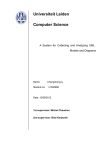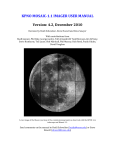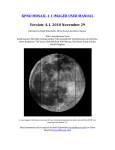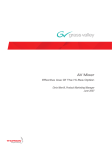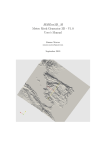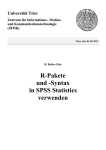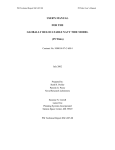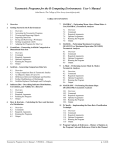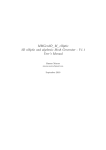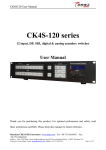Download Package `hyfo`
Transcript
Package ‘hyfo’ December 6, 2015 Type Package Title Hydrology and Climate Forecasting Version 1.3.4 Date 2015-12-5 Description Focuses on data processing and visualization in hydrology and climate forecasting. Main function includes data extraction, data downscaling, data resampling, gap filler of precipitation, bias correction of forecasting data, flexible time series plot, and spatial map generation. It is a good pre-processing and post-processing tool for hydrological and hydraulic modellers. License GPL-2 Depends R (>= 3.1.0), stats (>= 3.1.3), utils(>= 3.1.3), Imports ggplot2 (>= 1.0.1), reshape2 (>= 1.4.1), zoo (>= 1.7-12), rgdal (>= 0.8-16), plyr (>= 1.8.3), moments (>= 0.14), lmom (>= 2.5), maps(>= 2.3-9), maptools (>= 0.8-36), rgeos (>= 0.3-8), ncdf (>= 1.6.8), MASS (>= 7.3-39), methods Suggests gridExtra, knitr, rmarkdown VignetteBuilder knitr LazyData true URL http://yuanchao-xu.github.io/hyfo/ BugReports https://github.com/Yuanchao-Xu/hyfo/issues Repository CRAN NeedsCompilation no Author Yuanchao Xu [aut, cre] Maintainer Yuanchao Xu <[email protected]> Date/Publication 2015-12-06 00:21:39 1 R topics documented: 2 R topics documented: applyBiasFactor . . . . . biasCorrect . . . . . . . biasFactor-class . . . . . biasFactor.hyfo-class . . checkBind . . . . . . . . collectData . . . . . . . collectData_csv_anarbe . collectData_excel_anarbe collectData_txt_anarbe . coord2cell . . . . . . . . downscaleNcdf . . . . . extractPeriod . . . . . . fillGap . . . . . . . . . . getAnnual . . . . . . . . getAnnual_dataframe . . getBiasFactor . . . . . . getEnsem_comb . . . . . getFrcEnsem . . . . . . getHisEnsem . . . . . . getLMom . . . . . . . . getMeanPreci . . . . . . getMoment . . . . . . . getNcdfVar . . . . . . . getPreciBar . . . . . . . getPreciBar_comb . . . . getSpatialMap . . . . . . getSpatialMap_comb . . getSpatialMap_mat . . . list2Dataframe . . . . . . loadNcdf . . . . . . . . monthlyPreci . . . . . . plotTS . . . . . . . . . . plotTS_comb . . . . . . resample . . . . . . . . . shp2cat . . . . . . . . . testCat . . . . . . . . . . testdl . . . . . . . . . . . tgridData . . . . . . . . writeNcdf . . . . . . . . Index . . . . . . . . . . . . . . . . . . . . . . . . . . . . . . . . . . . . . . . . . . . . . . . . . . . . . . . . . . . . . . . . . . . . . . . . . . . . . . . . . . . . . . . . . . . . . . . . . . . . . . . . . . . . . . . . . . . . . . . . . . . . . . . . . . . . . . . . . . . . . . . . . . . . . . . . . . . . . . . . . . . . . . . . . . . . . . . . . . . . . . . . . . . . . . . . . . . . . . . . . . . . . . . . . . . . . . . . . . . . . . . . . . . . . . . . . . . . . . . . . . . . . . . . . . . . . . . . . . . . . . . . . . . . . . . . . . . . . . . . . . . . . . . . . . . . . . . . . . . . . . . . . . . . . . . . . . . . . . . . . . . . . . . . . . . . . . . . . . . . . . . . . . . . . . . . . . . . . . . . . . . . . . . . . . . . . . . . . . . . . . . . . . . . . . . . . . . . . . . . . . . . . . . . . . . . . . . . . . . . . . . . . . . . . . . . . . . . . . . . . . . . . . . . . . . . . . . . . . . . . . . . . . . . . . . . . . . . . . . . . . . . . . . . . . . . . . . . . . . . . . . . . . . . . . . . . . . . . . . . . . . . . . . . . . . . . . . . . . . . . . . . . . . . . . . . . . . . . . . . . . . . . . . . . . . . . . . . . . . . . . . . . . . . . . . . . . . . . . . . . . . . . . . . . . . . . . . . . . . . . . . . . . . . . . . . . . . . . . . . . . . . . . . . . . . . . . . . . . . . . . . . . . . . . . . . . . . . . . . . . . . . . . . . . . . . . . . . . . . . . . . . . . . . . . . . . . . . . . . . . . . . . . . . . . . . . . . . . . . . . . . . . . . . . . . . . . . . . . . . . . . . . . . . . . . . . . . . . . . . . . . . . . . . . . . . . . . . . . . . . . . . . . . . . . . . . . . . . . . . . . . . . . . . . . . . . . . . . . . . . . . . . . . . . . . . . . . . . . . . . . . . . . . . . . . . . . . . . . . . . . . . . . . . . . . . . . . . . . . . . . . . . . . . . . . . . . . . . . . . . . . . . . . . . . . . . . . . . . . . . . . . . . . . . . . . . . . . . . . . . . . . . . . . . . . . . . . . . . . . . . . . . . . . . . . . . . . . . . . . . . . . . . . . . . . . . . . . . . . . . . . . . . . . . . . . . . . . . . . . . . . . . . . . . . . . . . . . . . . . . . . . . . . . . . . . . . . . . . . . . . . . . . . . . . . . . . . . . . . . . . . . . . . . . . . . . . . . . . . . . . . . . . . . . . . . . . . . . . . . . . . . . . . . . . . . . . . . . . . . . . . . . . . . . . . . . . . . . . . . . . . . . . . . . . . . . . . . . . . . . . . . . . . . . . . . . . . . . . . . . . . . . . . . . . . . . . . . . . . . . . . . . . . . . . . . . . . . . . . . . . . . . . . . . . . . . . . . . . . . . . . . . . . . . . . . . . . . . . . . . . . . . . . . . . . . . . . . . . . . . . . . . . 3 6 11 11 12 12 13 14 15 16 16 17 19 21 23 23 27 28 30 32 33 34 34 35 37 38 39 41 42 43 44 45 46 47 49 50 50 51 51 53 applyBiasFactor 3 applyBiasFactor Apply bias factor to different forecasts for multi/operational/real time bias correction. Description When you do multi/operational/real time bias correction. It’s too expensive to input hindcast and obs every time. Especially when you have a long period of hindcast and obs, but only a short period of frc, it’s too unecessary to read and compute hindcast and obs everytime. Therefore, biasFactor is designed. Using getBiasFactor, you can get the biasFactor with hindcast and observation, then you can use applyBiasFactor to apply the biasFactor to different forecasts. Usage applyBiasFactor(frc, biasFactor, obs = NULL) ## S4 method for signature 'data.frame,biasFactor' applyBiasFactor(frc, biasFactor, obs = NULL) ## S4 method for signature 'list,biasFactor.hyfo' applyBiasFactor(frc, biasFactor, obs = NULL) Arguments frc a hyfo grid data output or a dataframe(time series) consists of Date column and one or more value columns, representing the frc data. Check details for more information. biasFactor a file containing all the information of the calibration, will be applied to different forecasts. obs for some methods, observation input is necessary. obs is a hyfo grid data output or a dataframe (time series) consists of Date column and one or more value columns, representing the observation data. Default value is NULL. Details Information about the method and how biasCorrect works can be found in biasCorrect why use biasFactor As for forecasting, for daily data, there is usually no need to have different bias factor every different day. You can calculate one bisa factor using a long period of hindcast and obs, and apply that factor to different frc. For example, You have 10 years of hindcast and observation. you want to do bias correction for some forecasting product, e.g. system 4. For system 4, each month, you will get a new forecast about the future 6 months. So if you want to do the real time bias correction, you have to take the 10 years of hindcast and observation data with you, and run biasCorrect every time you get a new forecast. That’s too expensive. 4 applyBiasFactor For some practical use in forecasting, there isn’t a so high demand for accuracy. E.g., Maybe for February and March, you can use the same biasFactor, no need to do the computation again. It is a generic function, if in your case you need to debug, please see ?debug() for how to debug S4 method. Methods (by class) • frc = data.frame,biasFactor = biasFactor: • frc = list,biasFactor = biasFactor.hyfo: Author(s) Yuanchao Xu <[email protected] > References Bias correction methods come from biasCorrection from dowscaleR • Santander Meteorology Group (2015). downscaleR: Climate data manipulation and statistical downscaling. R package version 0.6-0. https://github.com/SantanderMetGroup/downscaleR/wiki • R.A.I. Wilcke, T. Mendlik and A. Gobiet (2013) Multi-variable error correction of regional climate models. Climatic Change, 120, 871-887 • A. Amengual, V. Homar, R. Romero, S. Alonso, and C. Ramis (2012) A Statistical Adjustment of Regional Climate Model Outputs to Local Scales: Application to Platja de Palma, Spain. J. Clim., 25, 939-957 • C. Piani, J. O. Haerter and E. Coppola (2009) Statistical bias correction for daily precipitation in regional climate models over Europe, Theoretical and Applied Climatology, 99, 187-192 • O. Gutjahr and G. Heinemann (2013) Comparing precipitation bias correction methods for high-resolution regional climate simulations using COSMO-CLM, Theoretical and Applied Climatology, 114, 511-529 See Also biasCorrect for method used in bias correction. getBiasFactor, for the first part. Examples ######## hyfo grid file biascorrection ######## # If your input is obtained by \code{loadNcdf}, you can also directly biascorrect # the file. # First load ncdf file. filePath <- system.file("extdata", "tnc.nc", package = "hyfo") varname <- getNcdfVar(filePath) nc <- loadNcdf(filePath, varname) data(tgridData) applyBiasFactor 5 #' # Since the example data, has some NA values, the process will include some warning #message, # which can be ignored in this case. # Then we will use nc data as forecasting data, and use itself as hindcast data, # use tgridData as observation. biasFactor <- getBiasFactor(nc, tgridData) newFrc <- applyBiasFactor(nc, biasFactor) biasFactor <- getBiasFactor(nc, tgridData, method = 'eqm', extrapolate = 'constant', preci = TRUE) # This method needs obs input. newFrc <- applyBiasFactor(nc, biasFactor, obs = tgridData) biasFactor <- getBiasFactor(nc, tgridData, method = 'gqm', preci = TRUE) newFrc <- applyBiasFactor(nc, biasFactor) ######## Time series biascorrection ######## # Use the time series from testdl as an example, we take frc, hindcast and obs from testdl. data(testdl) # common period has to be extracted in order to better train the forecast. datalist <- extractPeriod(testdl, startDate = '1994-1-1', endDate = '1995-10-1') frc <- datalist[[1]] hindcast <- datalist[[2]] obs <- datalist[[3]] # The data used here is just for example, so there could be negative data. # default method is scaling biasFactor <- getBiasFactor(hindcast, obs) frc_new <- applyBiasFactor(frc, biasFactor) # for precipitation data, extra process needs to be executed, so you have to tell # the program to it is a precipitation data. biasFactor <- getBiasFactor(hindcast, obs, preci = TRUE) frc_new1 <- applyBiasFactor(frc, biasFactor) # You can use other methods to biascorrect, e.g. delta method. biasFactor <- getBiasFactor(hindcast, obs, method = 'delta') # delta method needs obs input. frc_new2 <- applyBiasFactor(frc, biasFactor, obs = obs) # 6 biasCorrect biasFactor <- getBiasFactor(hindcast, obs, method = 'eqm', preci = TRUE) # eqm needs obs input frc_new3 <- applyBiasFactor(frc, biasFactor, obs = obs) biasFactor <- getBiasFactor(hindcast, obs, method = 'gqm', preci = TRUE) frc_new4 <- applyBiasFactor(frc, biasFactor) plotTS(obs, frc, frc_new, frc_new1, frc_new2, frc_new3, frc_new4, plot = 'cum') # You can also give name to this input list. TSlist <- list(obs, frc, frc_new, frc_new1, frc_new2, frc_new3, frc_new4) names(TSlist) <- c('obs', 'frc', 'delta', 'delta_preci', 'scale', 'eqm', 'gqm') plotTS(list = TSlist, plot = 'cum') # # # # # If the forecasts you extracted only has incontinuous data for certain months and years, e.g., for seasonal forecasting, forecasts only provide 3-6 months data, so the case can be for example Dec, Jan and Feb of every year from year 1999-2005. In such case, you need to extract certain months and years from observed time series. extractPeriod() can be then used. # More examples can be found in the user manual on http://yuanchao-xu.github.io/hyfo/ biasCorrect Biascorrect the input timeseries or hyfo dataset Description Biascorrect the input time series or dataset, the input time series or dataset should consist of observation, hindcast, and forecast. observation and hindcast should belong to the same period, in order to calibrate. Then the modified forecast will be returned. If the input is a time series, first column should be date column and rest columns should be the value column. If the input is a hyfo dataset, the dataset should be the result of loadNcdf, or a list file with the same format. Usage biasCorrect(frc, hindcast, obs, method = "scaling", scaleType = "multi", preci = FALSE, prThreshold = 0, extrapolate = "no") ## S4 method for signature 'data.frame,data.frame,data.frame' biasCorrect(frc, hindcast, obs, method = "scaling", scaleType = "multi", preci = FALSE, prThreshold = 0, extrapolate = "no") ## S4 method for signature 'list,list,list' biasCorrect 7 biasCorrect(frc, hindcast, obs, method = "scaling", scaleType = "multi", preci = FALSE, prThreshold = 0, extrapolate = "no") Arguments frc a hyfo grid data output or a dataframe (time series) consists of Date column and one or more value columns, representing the forecast to be calibrated. hindcast a hyfo grid data output or a dataframe(time series) consists of Date column and one or more value columns, representing the hindcast data. This data will be used in the calibration of the forecast, so it’s better to have the same date period as observation data. Check details for more information. obs a hyfo grid data output or a dataframe (time series) consists of Date column and one or more value columns, representing the observation data. method bias correct method, including ’delta’, ’scaling’..., default is ’scaling’ scaleType only when the method "scaling" is chosen, scaleType will be available. Two different types of scaling method, ’add’ and ’multi’, which means additive and multiplicative scaling method. More info check details. Default scaleType is ’multi’. preci If the precipitation is biascorrected, then you have to assign preci = TRUE. Since for precipitation, some biascorrect methods may not apply to, or some methods are specially for precipitation. Default is FALSE, refer to details. prThreshold The minimum value that is considered as a non-zero precipitation. Default to 1 (assuming mm). extrapolate When use ’eqm’ method, and ’no’ is set, modified frc is bounded by the range of obs. If ’constant’ is set, modified frc is not bounded by the range of obs. Default is ’no’. Details Since climate forecast is based on global condition, when downscaling to different regions, it may include some bias, biascorrection is used then to fix the bias. Hindcast In order to bias correct, we need to pick up some data from the forecast to train with the observation, which is called hindcast in this function. Using hindcast and observation, the program can analyze the bias and correct the bias in the forecast. Hindcast should have EVERY attributes that forecast has. Hindcast is also called re-forecast, is the forecast of the past. E.g. you have a forecast from year 2000-2010, assuming now you are in 2005. So from 2000-2005, this period is the hindcast period, and 2005-2010, this period is the forecast period. Hindcast can be the same as forecast, i.e., you can use forecast itself as hindcast to train the bias correction. How it works 8 biasCorrect Forecast product has to be calibrated, usually the system is doing forecast in real time. So, e.g., if the forecast starts from year 2000, assuming you are in year 2003, then you will have 3 years’ hindcast data (year 2000-2003), which can be used to calibrate. And your forecast period is (2003-2004) E.g. you have observation from 2001-2002, this is your input obs. Then you can take the same period (2001-2002) from the forecast, which is the hindcast period. For forecast, you can take any period. The program will evaluate the obs and hindcast, to get the modification of the forecast, and then add the modification to the forecast data. The more categorized input, the more accurate result you will get. E.g., if you want to bias correct a forecast for winter season. So you’d better to extract all the winter period in the hindcast and observation to train. extractPeriod can be used for this purpose. method Different methods used in the bias correction. Among which, delta, scaling can be applied to different kinds of parameters, with no need to set preci; eqm has two conditions for rainfall data and other data, it needs user to input preci = TRUE/FALSE to point to different conditions; gqm is designed for rainfall data, so preci = TRUE needs to be set. delta This method consists on adding to the observations the mean change signal (delta method). This method is applicable to any kind of variable but it is preferable to avoid it for bounded variables (e.g. precipitation, wind speed, etc.) because values out of the variable range could be obtained (e.g. negative wind speeds...) scaling This method consists on scaling the simulation with the difference (additive) or quotient (multiplicative) between the observed and simulated means in the train period. The additive or multiplicative correction is defined by parameter scaling.type (default is additive). The additive version is preferably applicable to unbounded variables (e.g. temperature) and the multiplicative to variables with a lower bound (e.g. precipitation, because it also preserves the frequency). eqm Empirical Quantile Mapping. This is a very extended bias correction method which consists on calibrating the simulated Cumulative Distribution Function (CDF) by adding to the observed quantiles both the mean delta change and the individual delta changes in the corresponding quantiles. This method is applicable to any kind of variable. It can keep the extreme value, if you choose constant extrapolation method. But then you will face the risk that the extreme value is an error. gqm Gamma Quantile Mapping. This method is described in Piani et al. 2010 and is applicable only to precipitation. It is based on the initial assumption that both observed and simulated intensity distributions are well approximated by the gamma distribution, therefore is a parametric q-q map that uses the theorical instead of the empirical distribution. It can somehow filter some extreme values caused by errors, while keep the extreme value. Seems more reasonable. Better have a long period of training, and the if the forecast system is relatively stable. It is a generic function, if in your case you need to debug, please see ?debug() for how to debug S4 method. biasCorrect 9 Methods (by class) • frc = data.frame,hindcast = data.frame,obs = data.frame: • frc = list,hindcast = list,obs = list: Author(s) Yuanchao Xu <[email protected] > References Bias correction methods come from biasCorrection from dowscaleR • Santander Meteorology Group (2015). downscaleR: Climate data manipulation and statistical downscaling. R package version 0.6-0. https://github.com/SantanderMetGroup/downscaleR/wiki • R.A.I. Wilcke, T. Mendlik and A. Gobiet (2013) Multi-variable error correction of regional climate models. Climatic Change, 120, 871-887 • A. Amengual, V. Homar, R. Romero, S. Alonso, and C. Ramis (2012) A Statistical Adjustment of Regional Climate Model Outputs to Local Scales: Application to Platja de Palma, Spain. J. Clim., 25, 939-957 • C. Piani, J. O. Haerter and E. Coppola (2009) Statistical bias correction for daily precipitation in regional climate models over Europe, Theoretical and Applied Climatology, 99, 187-192 • O. Gutjahr and G. Heinemann (2013) Comparing precipitation bias correction methods for high-resolution regional climate simulations using COSMO-CLM, Theoretical and Applied Climatology, 114, 511-529 Examples ######## hyfo grid file biascorrection ######## # If your input is obtained by \code{loadNcdf}, you can also directly biascorrect # the file. # First load ncdf file. filePath <- system.file("extdata", "tnc.nc", package = "hyfo") varname <- getNcdfVar(filePath) nc <- loadNcdf(filePath, varname) data(tgridData) # Since the example data, has some NA values, the process will include some warning #message, # which can be ignored in this case. # Then we will use nc data as forecasting data, and use itself as hindcast data, # use tgridData as observation. newFrc <- biasCorrect(nc, nc, tgridData) newFrc <- biasCorrect(nc, nc, tgridData, scaleType = 'add') 10 biasCorrect newFrc <- biasCorrect(nc, nc, tgridData, method = 'eqm', extrapolate = 'constant', preci = TRUE) newFrc <- biasCorrect(nc, nc, tgridData, method = 'gqm', preci = TRUE) ######## Time series biascorrection ######## # Use the time series from testdl as an example, we take frc, hindcast and obs from testdl. data(testdl) # common period has to be extracted in order to better train the forecast. datalist <- extractPeriod(testdl, startDate = '1994-1-1', endDate = '1995-10-1') frc <- datalist[[1]] hindcast <- datalist[[2]] obs <- datalist[[3]] # The data used here is just for example, so there could be negative data. # default method is scaling, with 'multi' scaleType frc_new <- biasCorrect(frc, hindcast, obs) # for precipitation data, extra process needs to be executed, so you have to tell # the program that it is a precipitation data. frc_new1 <- biasCorrect(frc, hindcast, obs, preci = TRUE) # You can use other scaling methods to biascorrect. frc_new2 <- biasCorrect(frc, hindcast, obs, scaleType = 'add') # frc_new3 <- biasCorrect(frc, hindcast, obs, method = 'eqm', preci = TRUE) frc_new4 <- biasCorrect(frc, hindcast, obs, method = 'gqm', preci = TRUE) plotTS(obs, frc, frc_new, frc_new1, frc_new2, frc_new3, frc_new4, plot = 'cum') # You can also give name to this input list. TSlist <- list(obs, frc, frc_new, frc_new1, frc_new2, frc_new3, frc_new4) names(TSlist) <- c('obs', 'frc', 'delta', 'delta_preci', 'scale', 'eqm', 'gqm') plotTS(list = TSlist, plot = 'cum') # # # # # If the forecasts you extracted only has incontinuous data for certain months and years, e.g., for seasonal forecasting, forecasts only provide 3-6 months data, so the case can be for example Dec, Jan and Feb of every year from year 1999-2005. In such case, you need to extract certain months and years from observed time series. extractPeriod() can be then used. biasFactor-class 11 # More examples can be found in the user manual on http://yuanchao-xu.github.io/hyfo/ biasFactor-class An S4 class, representing the biasFactor of single time series biasCorrection. Description An S4 class, representing the biasFactor of single time series biasCorrection. Slots biasFactor list of biasFactor, containing all the information for computing. method the biascorrection method preci if the data is precipitation scaleType ’Valid when ’scaling’ method is selected, ’multi’ or ’add’. extrapolate Valid when ’eqm’ method is selected, ’constant’ or ’no’ memberDim members contained. prThreshold precipitation threshold, under which the precipitation is considered as 0. biasFactor.hyfo-class An S4 class, representing the biasFactor of hyfo file. Description An S4 class, representing the biasFactor of hyfo file. Slots lonLatDim lists of biasFactor 12 collectData checkBind Check data for bind function. Description check if the data is available for rbind() or cbind() Usage checkBind(data, bind) Arguments data A list containing different sublists ready to be processed by do.call('rbind') or do.call('cbind') bind A string showing which bind you are going to use can be ’rbind’ or ’cbind’ Value data can be processed by bind function; data cannot be processed by bind function Examples data <- list(c(1,1,1),c(2,2,2)) bind <- 'rbind' checkBind(data,bind) data(testdl) ## Not run: checkBind(testdl, 'rbind') ## End(Not run) # Since the colnames in testdl are not the same, so it cannot be bound. # collectData Collect data from different csv files. Description Collect data from different csv files. Usage collectData(folderName, fileType = NULL, range = NULL, sheetIndex = 1) collectData_csv_anarbe 13 Arguments folderName A string showing the path of the folder holding different csv files. fileType A string showing the file type, e.g. "txt", "csv", "excel". range A vector containing startRow, endRow, startColumn, endColumn, e.g., c(2,15,2,3) sheetIndex A number showing the sheetIndex in the excel file, if fileType is excel, sheetIndex has to be provided, default is 1. Value The collected data from different files in the folder. Examples #use internal data as an example. folder <- file.path(path.package("hyfo"), 'extdata') # file may vary with different environment, it if doesn't work, use local way to get # folder path. a <- collectData(folder, fileType = 'csv', range = c(10, 20, 1,2)) # More examples can be found in the user manual on http://yuanchao-xu.github.io/hyfo/ collectData_csv_anarbe Collect data from csv for Anarbe case. Description Collect data from the gauging stations in spain, catchement Anarbe Usage collectData_csv_anarbe(folderName, output = TRUE) Arguments folderName A string showing the path of the folder holding different csv files. output A boolean showing whether the output is given, default is T. Value The collected data from different csv files. Source http://meteo.navarra.es/estaciones/mapadeestaciones.cfm 14 collectData_excel_anarbe References • http://meteo.navarra.es/estaciones/mapadeestaciones.cfm • R Core Team (2015). R: A language and environment for statistical computing. R Foundation for Statistical Computing, Vienna, Austria. URL http://www.R-project.org/. Examples #use internal data as an example. file <- system.file("extdata", "1999.csv", package = "hyfo") folder <- strsplit(file, '1999')[[1]][1] a <- collectData_csv_anarbe(folder) # More examples can be found in the user manual on http://yuanchao-xu.github.io/hyfo/ collectData_excel_anarbe Collect data from different excel files Description Collect data from different excel files Usage collectData_excel_anarbe(folderName, keyword = NULL, output = TRUE) Arguments folderName A string showing the folder path. keyword A string showing the extracted column, e.g., waterLevel, waterBalance. output A boolean showing whether the output is given. Value The collected data from different excel files. References • R Core Team (2015). R: A language and environment for statistical computing. R Foundation for Statistical Computing, Vienna, Austria. URL http://www.R-project.org/. collectData_txt_anarbe 15 collectData_txt_anarbe collect data from different txt. Description collect data from different txt. Usage collectData_txt_anarbe(folderName, output = TRUE, rangeWord = c("Ene ", -1, "Total ", -6)) Arguments folderName A string showing the folder path. output A boolean showing whether the result is given. rangeWord A list containing the keyword and the shift. defaut is set to be used in spain gauging station. Value The collected data from different txt files. Source http://www4.gipuzkoa.net/oohh/web/esp/02.asp References • http://www4.gipuzkoa.net/oohh/web/esp/02.asp • R Core Team (2015). R: A language and environment for statistical computing. R Foundation for Statistical Computing, Vienna, Austria. URL http://www.R-project.org/. Examples #use internal data as an example. ## Not run: file <- system.file("extdata", "1999.csv", package = "hyfo") folder <- strsplit(file, '1999')[[1]][1] a <- collectData_txt_anarbe(folder) ## End(Not run) # More examples can be found in the user manual on http://yuanchao-xu.github.io/hyfo/ 16 downscaleNcdf coord2cell Change lon lat coordinates to cell coordinates Description Change lon lat coordinates to cell coordinates Usage coord2cell(coord, lon, lat) Arguments coord input lon lat coordinate lon dataset lon array lat dataset lat array Value A cell coordinate downscaleNcdf Downscale NetCDF file Description Downscale NetCDF file Usage downscaleNcdf(gridData, year = NULL, month = NULL, lon = NULL, lat = NULL) Arguments gridData A hyfo list file or the list file from loadECOMS{ecomsUDG.Raccess} or loadGridData{ecomsUDG.Racces year A vector of the target year. e.g. year = 2000, year = 1980:2000 month A vector of the target month. e.g. month = 2, month = 3:12 lon A vector of the range of the downscaled longitude, should contain a max value and a min value. e.g. lon = c(-1.5, 2,5) lat A vector of the range of the downscaled latitude, should contain a max value and a min value. e.g. lat = c(32,2, 36) extractPeriod 17 Value A downscaled hyfo list file. References • David Pierce (2014). ncdf: Interface to Unidata netCDF data files. R package version 1.6.8. http://CRAN.R-project.org/package=ncdf • Santander MetGroup (2015). ecomsUDG.Raccess: R interface to the ECOMS User Data Gateway. R package version 2.2-6. http://meteo.unican.es/ecoms-udg Examples # First open the test NETcDF file. filePath <- system.file("extdata", "tnc.nc", package = "hyfo") # Then if you don't know the variable name, you can use \code{getNcdfVar} to get variable name varname <- getNcdfVar(filePath) nc <- loadNcdf(filePath, varname) # Then write to your work directory nc1 <- downscaleNcdf(nc, year = 2006, lon = c(-2, -0.5), lat = c(43.2, 43.7)) nc2 <- downscaleNcdf(nc, year = 2005, month = 3:8, lon = c(-2, -0.5), lat = c(43.2, 43.7)) # More examples can be found in the user manual on http://yuanchao-xu.github.io/hyfo/ extractPeriod Extract period from list or dataframe. Description Extract common period or certain period from a list of different dataframes of time series, or from a dataframe. NOTE: all the dates in the datalist should follow the format in ?as.Datebase. Usage extractPeriod(data, startDate = NULL, endDate = NULL, commonPeriod = FALSE, year = NULL, month = NULL) ## S4 method for signature 'data.frame' extractPeriod(data, startDate = NULL, endDate = NULL, commonPeriod = FALSE, year = NULL, month = NULL) ## S4 method for signature 'list' extractPeriod(data, startDate = NULL, endDate = NULL, commonPeriod = FALSE, year = NULL, month = NULL) 18 extractPeriod Arguments data A list of different dataframes of time series, or a dataframe with first column Date, the rest columns value. startDate A Date showing the start of the extract period, default as NULL, check details. endDate A Date showing the end of the extract period, default as NULL, check details. commonPeriod A boolean showing whether the common period is extracted. If chosen, startDate and endDate should be NULL. year extract certain year in the entire time series. if you want to extract year 2000, set year = 2000 month extract certain months in a year. e.g. if you want to extract Jan, Feb of each year, set month = c(1, 2). Details startDate and endDate If startDate and endDate are assigned, then certain period between startDate and endDate will be returned, for both datalist input and dataframe input. If startDate and endDate are NOT assigned, then, if input is a datalist, the startDate and endDate of the common period of different datalists will be assigned to the startDate and endDate. if input is a dataframe, the startDate and endDate of the input dataframe will be assigned to the startDate and endDate . Since different value columns share a common Date column in a dataframe input. year and month For year crossing month input, hyfo will take from the year before. E.g. if month = c(10, 11, 12, 1), and year = 1999, hyfo will take month 10, 11 and 12 from year 1998, and month 1 from 1999.You DO NOT have to set year = 1998 : 1999. Well, if you set year = 1998 : 1999, hyfo will take month 10, 11 and 12 from year 1997, and month 1 from 1998, then, take month 10, 11 and 12 from year 1998, month 1 from 1999. So you only have to care about the latter year. It is a generic function, if in your case you need to debug, please see ?debug() for how to debug S4 method. Value A list or a dataframe with all the time series inside containing the same period. Methods (by class) • data.frame: • list: fillGap 19 References • Achim Zeileis and Gabor Grothendieck (2005). zoo: S3 Infrastructure for Regular and Irregular Time Series. Journal of Statistical Software, 14(6), 1-27. URL http://www.jstatsoft.org/v14/i06/ Examples # Generate timeseries datalist. Each data frame consists of a Date and a value. AAA <- data.frame( # date column Date = seq(as.Date('1990-10-28'),as.Date('1997-4-1'),1), # value column AAA = sample(1:100,length(seq(as.Date('1990-10-28'),as.Date('1997-4-1'),1)), repl = TRUE)) BBB <- data.frame( Date = seq(as.Date('1993-3-28'),as.Date('1999-1-1'),1), BBB = sample(1:100,length(seq(as.Date('1993-3-28'),as.Date('1999-1-1'),1)), repl = TRUE)) CCC <- data.frame( Date = seq(as.Date('1988-2-2'),as.Date('1996-1-1'),1), CCC = sample(1:100,length(seq(as.Date('1988-2-2'),as.Date('1996-1-1'),1)), repl = TRUE)) list <- list(AAA, BBB, CCC)# dput() and dget() can be used to save and load list file. list_com <- extractPeriod(list, commonPeriod = TRUE) # list_com is the extracted datalist. str(list_com) # If startDate and endDate is provided, the record between them will be extracted. # make sure startDate is later than any startDate in each dataframe and endDate is # earlier than any endDate in each dataframe. data(testdl) datalist_com1 <- extractPeriod(testdl, startDate = '1994-1-1', endDate = '1995-10-1') dataframe <- list2Dataframe(datalist_com1) # now we have a dataframe to extract certain months and years. dataframe_new <- extractPeriod(dataframe, month = c(1,2,3)) dataframe_new <- extractPeriod(dataframe, month = c(12,1,2), year = 1995) # More examples can be found in the user manual on http://yuanchao-xu.github.io/hyfo/ fillGap Fill gaps in the rainfall time series. 20 fillGap Description Fill gaps in the rainfall time series. Usage fillGap(dataset, corPeriod = "daily") Arguments dataset A dataframe with first column the time, the rest columns are rainfall data of different gauges corPeriod A string showing the period used in the correlation computing, e.g. daily, monthly, yearly. Details the gap filler follows the rules below: 1. The correlation coefficient of every two columns (except time column) is calculated. the correlation coefficient calculation can be based on ’daily’, ’monthly’, ’annual’, in each case, the daily data, the monthly mean daily data and annual mean daily data of each column will be taken in the correlation calculation. Then the correlation matrix is got, then based on the matrix, for each column, the 1st, 2nd, 3rd,... correlated column will be got. So if there is missing value in the column, it will get data from orderly 1st, 2nd, 3rd column. 2. The simple linear regress is calculated between every two columns. When generating the linear coefficient, the incept should be force to 0. i.e. y = a*x + b should be forec to y = a*x. 3. Gap filling. E.g., on a certain date, there is a missing value in column A, then the correlation order is column B, column C, column D, which means A should take values from B firstly, if B is also missing data, then C, then D. Assuming finally value from column C is taken. Then according to step 2, A = a*C, then the final value filled in column A is missing_in_A = a*value_in_C, a is the linear coeffcient. Value The filled dataframe References Gap fiiling method based on correlation and linear regression. • Hirsch, Robert M., et al. "Statistical analysis of hydrologic data." Handbook of hydrology. (1992): 17-1. Salas, Jose D. "Analysis and modeling of hydrologic time series." Handbook of hydrology 19 (1993): 1-72. getAnnual 21 Examples b <- read.table(text = ' Date AAA 49 1999-12-15 24.8 21.4 25.6 35.0 17.4 50 1999-12-16 NA 0.6 1.5 6.3 2.5 51 1999-12-17 NA 16.3 20.3 NA 19.2 52 1999-12-18 13 1.6 NA 6.3 0.0 53 1999-12-19 10 36.4 12.5 26.8 24.9 54 1999-12-20 NA 0.0 0.0 0.2 0.0 55 1999-12-21 0.2 0.0 0.0 0.0 0.0 56 1999-12-22 0.0 0.0 0.0 0.0 0.0') BBB CCC DDD EEE b1 <- fillGap(b) # if corPeriod is missing, 'daily' is taken as default. data(testdl) a <- extractPeriod(testdl, commonPeriod = TRUE) a1 <- list2Dataframe(a) a2 <- fillGap(a1) a3 <- fillGap(a1, corPeriod = 'monthly') # More examples can be found in the user manual on http://yuanchao-xu.github.io/hyfo/ getAnnual Get annual rainfall of different rainfall time series Description Get annual rainfall of different raninfall time series. Usage getAnnual(data, output = "series", minRecords = 355, ...) ## S4 method for signature 'data.frame' getAnnual(data, output = "series", minRecords = 355, ...) ## S4 method for signature 'list' getAnnual(data, output = "series", minRecords = 355, ...) Arguments data A list containing different time series of different rainfall gauges. Or a dataframe with first column Date and the rest columns the value of different gauging stations. Usually an output of list2Dataframe. output A string showing the output output. 22 getAnnual minRecords A number showing the minimum accept record number, e.g. for a normal year(365 days), if minRecords = 360, it means if a year has less than 360 records of a year, it will be ignored in the mean annual value calculation. Only valid when output = "mean", default is 355. ... title, x, y showing the title and x and y axis of the plot. e.g. title = 'aaa' Details It is a generic function, if in your case you need to debug, please see ?debug() for how to debug S4 method. Value The annual rainfall and the number of missing data of each year and each rainfall gauge, which will also be plotted. If output "mean" is seleted, the mean annual rainfall will be returned. Methods (by class) • data.frame: • list: References • H. Wickham. ggplot2: elegant graphics for data analysis. Springer New York, 2009. • Hadley Wickham (2007). Reshaping Data with the reshape Package. Journal of Statistical Software, 21(12), 1-20. URL http://www.jstatsoft.org/v21/i12/. • R Core Team (2015). R: A language and environment for statistical computing. R Foundation for Statistical Computing, Vienna, Austria. URL http://www.R-project.org/. Examples #datalist is provided by the package as a test. data(testdl) a <- getAnnual(testdl) #set minRecords to control the calculation of annual rainfall. b <- getAnnual(testdl, output = 'mean', minRecords = 350) c <- getAnnual(testdl, output = 'mean', minRecords = 365) a1 <- extractPeriod(testdl, comm = TRUE) a2 <- list2Dataframe(a1) getAnnual(a2) a3 <- fillGap(a2) getAnnual(a3) # More examples can be found in the user manual on http://yuanchao-xu.github.io/hyfo/ getAnnual_dataframe 23 getAnnual_dataframe Get annual rainfall of the input time series. Description Get annual rainfall of the input time series. Usage getAnnual_dataframe(dataset) Arguments dataset A dataframe containing one time series, e.g., rainfall from one gauging station. the time should follow the format : "1990-1-1" Value The annual rainfall of each year of the input station. getBiasFactor Get bias factor for multi/operational/real time bias correction. Description When you do multi/operational/real time bias correction. It’s too expensive to input hindcast and obs every time. Especially when you have a long period of hindcast and obs, but only a short period of frc, it’s too unecessary to read and compute hindcast and obs everytime. Therefore, biasFactor is designed. Using getBiasFactor, you can get the biasFactor with hindcast and observation, then you can use applyBiasFactor to apply the biasFactor to different forecasts. Usage getBiasFactor(hindcast, obs, method = "scaling", scaleType = "multi", preci = FALSE, prThreshold = 0, extrapolate = "no") ## S4 method for signature 'data.frame,data.frame' getBiasFactor(hindcast, obs, method = "scaling", scaleType = "multi", preci = FALSE, prThreshold = 0, extrapolate = "no") ## S4 method for signature 'list,list' getBiasFactor(hindcast, obs, method = "scaling", scaleType = "multi", preci = FALSE, prThreshold = 0, extrapolate = "no") 24 getBiasFactor Arguments hindcast a hyfo grid data output or a dataframe(time series) consists of Date column and one or more value columns, representing the hindcast data. This data will be used in the calibration of the forecast, so it’s better to have the same date period as observation data. Check details for more information. obs a hyfo grid data output or a dataframe (time series) consists of Date column and one or more value columns, representing the observation data. method bias correct method, including ’delta’, ’scaling’...,default method is ’scaling’. scaleType only when the method "scaling" is chosen, scaleType will be available. Two different types of scaling method, ’add’ and ’multi’, which means additive and multiplicative scaling method, default is ’multi’. More info check details. preci If the precipitation is biascorrected, then you have to assign preci = TRUE. Since for precipitation, some biascorrect methods may not apply to, or some methods are specially for precipitation. Default is FALSE, refer to details. prThreshold The minimum value that is considered as a non-zero precipitation. Default to 1 (assuming mm). extrapolate When use ’eqm’ method, and ’no’ is set, modified frc is bounded by the range of obs. If ’constant’ is set, modified frc is not bounded by the range of obs. Default is ’no’. Details Information about the method and how biasCorrect works can be found in biasCorrect why use biasFactor As for forecasting, for daily data, there is usually no need to have different bias factor every different day. You can calculate one bisa factor using a long period of hindcast and obs, and apply that factor to different frc. For example, You have 10 years of hindcast and observation. you want to do bias correction for some forecasting product, e.g. system 4. For system 4, each month, you will get a new forecast about the future 6 months. So if you want to do the real time bias correction, you have to take the 10 years of hindcast and observation data with you, and run biasCorrect every time you get a new forecast. That’s too expensive. For some practical use in forecasting, there isn’t a so high demand for accuracy. E.g., Maybe for February and March, you can use the same biasFactor, no need to do the computation again. It is a generic function, if in your case you need to debug, please see ?debug() for how to debug S4 method. Methods (by class) • hindcast = data.frame,obs = data.frame: • hindcast = list,obs = list: getBiasFactor 25 Author(s) Yuanchao Xu <[email protected] > References Bias correction methods come from biasCorrection from dowscaleR • Santander Meteorology Group (2015). downscaleR: Climate data manipulation and statistical downscaling. R package version 0.6-0. https://github.com/SantanderMetGroup/downscaleR/wiki • R.A.I. Wilcke, T. Mendlik and A. Gobiet (2013) Multi-variable error correction of regional climate models. Climatic Change, 120, 871-887 • A. Amengual, V. Homar, R. Romero, S. Alonso, and C. Ramis (2012) A Statistical Adjustment of Regional Climate Model Outputs to Local Scales: Application to Platja de Palma, Spain. J. Clim., 25, 939-957 • C. Piani, J. O. Haerter and E. Coppola (2009) Statistical bias correction for daily precipitation in regional climate models over Europe, Theoretical and Applied Climatology, 99, 187-192 • O. Gutjahr and G. Heinemann (2013) Comparing precipitation bias correction methods for high-resolution regional climate simulations using COSMO-CLM, Theoretical and Applied Climatology, 114, 511-529 See Also biasCorrect for method used in bias correction. applyBiasFactor, for the second part. Examples ######## hyfo grid file biascorrection ######## # If your input is obtained by \code{loadNcdf}, you can also directly biascorrect # the file. # First load ncdf file. filePath <- system.file("extdata", "tnc.nc", package = "hyfo") varname <- getNcdfVar(filePath) nc <- loadNcdf(filePath, varname) data(tgridData) # Since the example data, has some NA values, the process will include some warning #message, # which can be ignored in this case. # Then we will use nc data as forecasting data, and use itself as hindcast data, # use tgridData as observation. biasFactor <- getBiasFactor(nc, tgridData) newFrc <- applyBiasFactor(nc, biasFactor) biasFactor <- getBiasFactor(nc, tgridData, method = 'eqm', extrapolate = 'constant', 26 getBiasFactor preci = TRUE) # This method needs obs input. newFrc <- applyBiasFactor(nc, biasFactor, obs = tgridData) biasFactor <- getBiasFactor(nc, tgridData, method = 'gqm', preci = TRUE) newFrc <- applyBiasFactor(nc, biasFactor) ######## Time series biascorrection ######## # Use the time series from testdl as an example, we take frc, hindcast and obs from testdl. data(testdl) # common period has to be extracted in order to better train the forecast. datalist <- extractPeriod(testdl, startDate = '1994-1-1', endDate = '1995-10-1') frc <- datalist[[1]] hindcast <- datalist[[2]] obs <- datalist[[3]] # The data used here is just for example, so there could be negative data. # default method is scaling biasFactor <- getBiasFactor(hindcast, obs) frc_new <- applyBiasFactor(frc, biasFactor) # for precipitation data, extra process needs to be executed, so you have to tell # the program to it is a precipitation data. biasFactor <- getBiasFactor(hindcast, obs, preci = TRUE) frc_new1 <- applyBiasFactor(frc, biasFactor) # You can use other methods to biascorrect, e.g. delta method. biasFactor <- getBiasFactor(hindcast, obs, method = 'delta') # delta method needs obs input. frc_new2 <- applyBiasFactor(frc, biasFactor, obs = obs) # biasFactor <- getBiasFactor(hindcast, obs, method = 'eqm', preci = TRUE) # eqm needs obs input frc_new3 <- applyBiasFactor(frc, biasFactor, obs = obs) biasFactor <- getBiasFactor(hindcast, obs, method = 'gqm', preci = TRUE) frc_new4 <- applyBiasFactor(frc, biasFactor) plotTS(obs, frc, frc_new, frc_new1, frc_new2, frc_new3, frc_new4, plot = 'cum') # You can also give name to this input list. TSlist <- list(obs, frc, frc_new, frc_new1, frc_new2, frc_new3, frc_new4) names(TSlist) <- c('obs', 'frc', 'delta', 'delta_preci', 'scale', 'eqm', 'gqm') getEnsem_comb 27 plotTS(list = TSlist, plot = 'cum') # # # # # If the forecasts you extracted only has incontinuous data for certain months and years, e.g., for seasonal forecasting, forecasts only provide 3-6 months data, so the case can be for example Dec, Jan and Feb of every year from year 1999-2005. In such case, you need to extract certain months and years from observed time series. extractPeriod() can be then used. # More examples can be found in the user manual on http://yuanchao-xu.github.io/hyfo/ getEnsem_comb Combine ensembles together Description Combine ensembles together Usage getEnsem_comb(..., list = NULL, nrow = 1, legend = TRUE, x = "", y = "", title = "", output = FALSE) Arguments ... different ensembles generated by getHisEnsem(, output = 'ggplot') or getFrcEnsem(, output = 'ggplot'), see details. list If input is a list containing different ggplot data, use list = inputlist. nrow A number showing the number of rows. legend A boolean representing whether you want the legend. Sometimes when you combine plots, there will be a lot of legends, if you don’t like it, you can turn it off by setting legend = FALSE, default is TRUE. x A string of x axis name. y A string of y axis name. title A string of the title. output A boolean, if chosen TRUE, the output will be given. Value A combined ensemble plot. 28 getFrcEnsem References • H. Wickham. ggplot2: elegant graphics for data analysis. Springer New York, 2009. • Santander Meteorology Group (2015). downscaleR: Climate data manipulation and statistical downscaling. R package version 0.6-0. https://github.com/SantanderMetGroup/downscaleR/wiki Examples data(testdl) a <- testdl[[1]] # Choose example from "1994-2-4" to "1996-1-4" b1<- getHisEnsem(a, example = c('1995-2-4', '1996-1-4'), plot = 'cum', output = 'ggplot', name = 1) b2 <- getHisEnsem(a, example = c('1995-4-4', '1996-3-4'), plot = 'cum', output = 'ggplot', name = 2) getEnsem_comb(b1, b2) getEnsem_comb(list = list(b1, b2), nrow = 2) # More examples can be found in the user manual on http://yuanchao-xu.github.io/hyfo/ getFrcEnsem Extract time series from forecasting data. Description getFrcEnsem extract timeseries from forecasting data, if forecasting data has a member session an ensemble time sereis will be returned, if forecasting data doesn’t have a member session, a singe time series will be returned. Usage getFrcEnsem(dataset, cell = "mean", plot = "norm", output = "data", name = NULL, mv = 0, coord = NULL, ...) Arguments dataset A list containing different information, should be the result of reading netcdf file using library(ecomsUDG.Raccess). cell A vector containing the locaton of the cell, e.g. c(2, 3), default is "mean", representing the spatially averaged value. Check details for more information. plot A string showing whether the plot will be shown, e.g., ’norm’ means normal plot (without any process), ’cum’ means cummulative plot, default is ’norm’. For other words there will be no plot. getFrcEnsem 29 output A string showing which type of output you want. Default is "data", if "ggplot", the data that can be directly plotted by ggplot2 will be returned, which is easier for you to make series plots afterwards. NOTE: If output = 'ggplot', the missing value in the data will be replaced by mv, if assigned, default mv is 0. name If output = 'ggplot', name has to be assigned to your output, in order to differentiate different outputs in the later multiplot using getEnsem_comb. mv A number showing representing the missing value. When calculating the cumulative value, missing value will be replaced by mv, default is 0. coord A coordinate of longitude and latitude. e.g. corrd = c(lon, lat). If coord is assigned, cell argument will no longer be used. ... title, x, y showing the title and x and y axis of the plot. e.g. title = 'aaa' Details cell representing the location of the cell, NOTE: this location means the index of the cell, IT IS NOT THE LONGITUDE AND LATITUDE. e.g., cell = c(2, 3), the program will take the 2nd longitude and 3rd latitude, by the increasing order. Longitude comes first. name Assuming you have two ggplot outputs, you want to plot them together. In this situation, you need a name column to differentiate one ggplot output from the other. You can assigne this name by the argument directly, If name is not assigned and output = 'ggplot' is selected, then the system time will be selected as name column. Value A ensemble time series extracted from forecating data. References • H. Wickham. ggplot2: elegant graphics for data analysis. Springer New York, 2009. • Hadley Wickham (2007). Reshaping Data with the reshape Package. Journal of Statistical Software, 21(12), 1-20. URL http://www.jstatsoft.org/v21/i12/. • Santander Meteorology Group (2015). downscaleR: Climate data manipulation and statistical downscaling. R package version 0.6-0. https://github.com/SantanderMetGroup/downscaleR/wiki Examples filePath <- system.file("extdata", "tnc.nc", package = "hyfo") # Then if you don't know the variable name, you can use \code{getNcdfVar} to get variable name varname <- getNcdfVar(filePath) nc <- loadNcdf(filePath, varname) a <- getFrcEnsem(nc) # If there is no member session in the dataset, a single time sereis will be extracted. a1 <- getFrcEnsem(tgridData) # The default output is spatially averaged, if there are more than one cells in the dataset, # the mean value of the cells will be calculated. While if you are interested in special cell, 30 getHisEnsem # you can assign the cell value. You can also directly use longitude and latitude to extract # time series. getSpatialMap(nc, 'mean') a <- getFrcEnsem(nc, cell = c(6,2)) # From the map, cell = c(6, 2) means lon = -1.4, lat = 43.2, so you can use corrd to locate # your research area and extract time series. b <- getFrcEnsem(nc, coord = c(-1.4, 43.2)) # More examples can be found in the user manual on http://yuanchao-xu.github.io/hyfo/ getHisEnsem Get ensemble forecast from historical data. Description getHisEnsem use historical data as the forecasting input time series. Usage getHisEnsem(TS, example, interval = 365, buffer = 0, plot = "norm", output = "data", name = NULL, mv = 0, ...) Arguments TS A time series dataframe, with first column Date, and second column value. example A vector containing two strings showing the start and end date, which represent the forecasting period. Check details for more information. the program will extract every possible period in TS you provided to generate the ensemble. Check details for more information. interval A number representing the interval of each ensemble member. NOTE: "interval" takes 365 as a year, and 30 as a month, regardless of leap year and months with 31 days. So if you want the interval to be 2 years, set interval = 730, which equals 2 * 365 ; if two months, set interval = 60; 2 days, interval = 2, for other numbers that cannot be divided by 365 or 30 without remainder, it will treat the number as days.By defualt interval is set to be 365, a year. buffer A number showing how many days are used as buffer period for models. Check details for more information. plot A string showing whether the plot will be shown, e.g., ’norm’ means normal plot (without any process), ’cum’ means cummulative plot, default is ’norm’. For other words there will be no plot. output A string showing which type of output you want. Default is "data", if "ggplot", the data that can be directly plotted by ggplot2 will be returned, which is easier for you to make series plots afterwards. NOTE: If output = 'ggplot', the missing value in the data will be replaced by mv, if assigned, default mv is 0. getHisEnsem 31 name If output = 'ggplot', name has to be assigned to your output, in order to differentiate different outputs in the later multiplot using getEnsem_comb. mv A number showing representing the missing value. When calculating the cumulative value, missing value will be replaced by mv, default is 0. ... title, x, y showing the title and x and y axis of the plot. e.g. title = 'aaa' Details example E.g., if you have a time series from 2000 to 2010. Assuming you are in 2003, you want to forecast the period from 2003-2-1 to 2003-4-1. Then for each year in your input time series, every year from 1st Feb to 1st Apr will be extracted to generate the ensemble forecasts. In this case your input example should be example = c('2003-2-1', '2003-4-1') interval doesn’t care about leap year and the months with 31 days, it will take 365 as a year, and 30 as a month. e.g., if the interval is from 1999-2-1 to 1999-3-1, you should just set interval to 30, although the real interval is 28 days. example and interval controls how the ensemble will be generated. e.g. if the time series is from 1990-1-1 to 2001-1-1. if example = c('1992-3-1', '1994-1-1') and interval = 1095, note, 1095 = 365 * 3, so the program treat this as 3 years. Then you are supposed to get the ensemble consisting of following part: 1. 1992-3-1 to 1994-1-1 first one is the example, and it’s NOT start from 1990-3-1. 2. 1995-3-1 to 1997-1-1 second one starts from 1993, because "interval" is 3 years. 3. 1998-3-1 to 2000-1-1 because the last one "2000-3-1 to 2002-1-1", 2002 exceeds the original TS range, so it will not be included. Sometimes, there are leap years and months with 31 days included in some ensemble part, in which case the length of the data will be different, e.g., 1999-1-1 to 1999-3-1 is 1 day less than 2000-1-1 to 2000-3-1. In this situation, the data will use example as a standard. If the example is 1999-1-1 to 1999-3-1, then the latter one will be changed to 2001-1-1 to 2000-2-29, which keeps the start Date and change the end Date. If the end date is so important that cannot be changed, try to solve this problem by resetting the example period, to make the event included in the example. Good set of example and interval can generate good ensemble. buffer Sometimes the model needs to run for a few days to warm up, before the forecast. E.g., if a forecast starts at ’1990-1-20’, for some model like MIKE NAM model, the run needs to be started about 14 days. So the input timeseries should start from ’1990-1-6’. Buffer is mainly used for the model hotstart. Sometimes the hot start file cannot contain all the parameters needed, only some important parameters. In this case, the model needs to run for some time, to make other parameters ready for the simulation. name Assuming you have two ggplot outputs, you want to plot them together. In this situation, you need a name column to differentiate one ggplot output from the other. You can assigne this name by the argument directly, name has to be assigned if output = 'ggplot' is selected, Value A ensemble time series using historical data as forecast. 32 getLMom References • Hadley Wickham (2007). Reshaping Data with the reshape Package. Journal of Statistical Software, 21(12), 1-20. URL http://www.jstatsoft.org/v21/i12/. • H. Wickham. ggplot2: elegant graphics for data analysis. Springer New York, 2009. Examples data(testdl) a <- testdl[[1]] # Choose example from "1994-2-4" to "1996-1-4" b <- getHisEnsem(a, example = c('1994-2-4', '1996-1-4')) # Default interval is one year, can be set to other values, check help for information. # b # b Take 7 months as interval <- getHisEnsem(a, example = c('1994-2-4', '1996-1-4'), interval = 210, plot = 'cum') Take 30 days as buffer <- getHisEnsem(a, example = c('1994-2-4', '1996-1-4'), interval = 210, buffer = 30) # More examples can be found in the user manual on http://yuanchao-xu.github.io/hyfo/ getLMom get L moment analysis of the input distribution Description get L moment analysis of the input distribution Usage getLMom(dis) Arguments dis A distribution, for hydrology usually a time series with only data column without time. Value The mean, L-variation, L-skewness and L-kurtosis of the input distribution References • J. R. M. Hosking (2015). L-moments. R package, version 2.5. URL: http://CRAN.Rproject.org/package=lmom. getMeanPreci 33 Examples dis <- seq(1, 100) getLMom(dis) # More examples can be found in the user manual on http://yuanchao-xu.github.io/hyfo/ getMeanPreci Get mean rainfall data. Description Get mean rainfall data, e.g. mean annual rainfall, mean monthly rainfall and mean winter rainfall. Usage getMeanPreci(inputTS, method = NULL, yearIndex = NULL, monthIndex = NULL, fullResults = FALSE, omitNA = TRUE, plot = FALSE, ...) Arguments inputTS A time series with only data column (1 column). method A string showing the method used to calculate mean value, e.g., "annual". more information please refer to details. yearIndex A NUMERIC ARRAY showing the year index of the time series. monthIndex A NUMERIC ARRAY showing the month index of the time series. fullResults A boolean showing whether the full results are shown, default is FALSE. If FALSE, only mean value will be returned, if TRUE, the sequence of values will be returned. omitNA A boolean showing in the calculation, whether NA is omitted, default is FALSE. plot A boolean showing whether the results will be plotted. ..., title, x, y showing the title and x and y axis of the plot, shoud be a string. Details There are following methods to be selected, "annual": annual rainfall of each year is plotted. "winter", "spring", "autumn", "summer": seasonal rainfall of each year is plotted. Month(number 1 to 12): month rainfall of each year is plotted, e.g. march rainfall of each year. "meanMonthly": the mean monthly rainfall of each month over the whole period. Since "winter" is a crossing year, 12, 1, 2, 12 is in former year, and 1, 2 are in latter year. so winter belongs to the latter year. Value The mean value of the input time series or the full results before calculating mean. 34 getNcdfVar getMoment get moment analysis of the input distribution Description get moment analysis of the input distribution Usage getMoment(dis) Arguments dis A distribution, for hydrology usually a time series with only data column without time. Value The mean, variation, skewness and kurtosis of the input distribution References • Lukasz Komsta and Frederick Novomestky (2015). moments: Moments, cumulants, skewness, kurtosis and related tests. R package version 0.14. http://CRAN.R-project.org/package=moments • R Core Team (2015). R: A language and environment for statistical computing. R Foundation for Statistical Computing, Vienna, Austria. URL http://www.R-project.org/. Examples dis <- seq(1, 100) getMoment(dis) # More examples can be found in the user manual on http://yuanchao-xu.github.io/hyfo/ getNcdfVar Get variable name of the NetCDF file. Description Get variable name in the NetCDF file. After knowning the name, you can use loadNcdf to load the target variable. Usage getNcdfVar(filePath) getPreciBar 35 Arguments filePath A path pointing to the netCDF file. Value The names of the varialbes in the file. References • David Pierce (2014). ncdf: Interface to Unidata netCDF data files. R package version 1.6.8. http://CRAN.R-project.org/package=ncdf Examples # First open the test NETcDF file. filePath <- system.file("extdata", "tnc.nc", package = "hyfo") # Then if you don't know the variable name, you can use \code{getNcdfVar} to get variable name varname <- getNcdfVar(filePath) # More examples can be found in the user manual on http://yuanchao-xu.github.io/hyfo/ getPreciBar get mean rainfall bar plot of the input dataset or time series. Description get mean rainfall bar plot of the input dataset or time series. Usage getPreciBar(data, method, cell = "mean", output = "data", name = NULL, plotRange = TRUE, member = NULL, omitNA = TRUE, info = FALSE, ...) ## S4 method for signature 'list' getPreciBar(data, method, cell = "mean", output = "data", name = NULL, plotRange = TRUE, member = NULL, omitNA = TRUE, info = FALSE, ...) ## S4 method for signature 'data.frame' getPreciBar(data, method, cell = "mean", output = "data", name = NULL, plotRange = TRUE, member = NULL, omitNA = TRUE, info = FALSE, ...) 36 getPreciBar Arguments data A list containing different information, should be the result of reading netcdf file using loadNcdf, or load functions from ecomsUDG.Raccess, or a time series, with first column the Date, second the value. Time series can be an ENSEMBLE containning different members. Than the mean value will be given and the range will be given. method A string showing the calculating method of the input time series. More information please refer to the details. cell A vector containing the locaton of the cell, e.g. c(2, 3), default is "mean", representing the spatially averaged value. Check details for more information. output A string showing the type of the output, if output = 'ggplot', the returned data can be used in ggplot and getPreciBar_comb(); if output = 'plot', the returned data is the plot containing all layers’ information, and can be plot directly or used in grid.arrange; if not set, the data will be returned. name If output = 'ggplot', name has to be assigned to your output, in order to differentiate different outputs in the later multiplot using getSpatialMap_comb. plotRange A boolean showing whether the range will be plotted. member A number showing which member is selected to get, if the dataset has a "member" dimension. Default is NULL, if no member assigned, and there is a "member" in dimensions, the mean value of the members will be taken. omitNA A boolean showing whether the missing value is omitted. info A boolean showing whether the information of the map, e.g., max, mean ..., default is FALSE. ... title, x, y showing the title and x and y axis of the plot. e.g. title = 'aaa' Details There are following methods to be selected, "annual": annual rainfall of each year is plotted. "winter", "spring", "autumn", "summer": seasonal rainfall of each year is plotted. Month(number 1 to 12): month rainfall of each year is plotted, e.g. march rainfall of each year. "meanMonthly": the mean monthly rainfall of each month over the whole period. #Since "winter" is a crossing year, 12, 1, 2, 12 is in former year, and 1, 2 are in latter year. #so winter belongs to the latter year. cell representing the location of the cell, NOTE: this location means the index of the cell, IT IS NOT THE LONGITUDE AND LATITUDE. e.g., cell = c(2, 3), the program will take the 2nd longitude and 3rd latitude, by the increasing order. Longitude comes first. It is a generic function, if in your case you need to debug, please see ?debug() for how to debug S4 method. Value The calculated mean value of the input time series and the plot of the result. getPreciBar_comb 37 Methods (by class) • list: • data.frame: References • Hadley Wickham (2007). Reshaping Data with the reshape Package. Journal of Statistical Software, 21(12), 1-20. URL http://www.jstatsoft.org/v21/i12/. • H. Wickham. ggplot2: elegant graphics for data analysis. Springer New York, 2009. • R Core Team (2015). R: A language and environment for statistical computing. R Foundation for Statistical Computing, Vienna, Austria. URL http://www.R-project.org/. Examples #gridData provided by package is the result of \code{loadNcdf()} data(tgridData) b1 <- getPreciBar(tgridData, method = 'annual') b2 <- getPreciBar(tgridData, method = 'meanMonthly') data(testdl) TS <- testdl[[1]] a <- getPreciBar(TS, method = 'spring') # if info = T, the information will be given at the bottom. a <- getPreciBar(TS, method = 'spring', info = TRUE) # More examples can be found in the user manual on http://yuanchao-xu.github.io/hyfo/ getPreciBar_comb Combine bars together Description Combine bars together Usage getPreciBar_comb(..., list = NULL, nrow = 1, x = "", y = "", title = "", output = FALSE) Arguments ... different barplots generated by getPreciBar(, output = 'ggplot'), refer to details. list If input is a list containing different ggplot data, use llist = inputlist. NOTE: yOU HAVE TO PUT A list = , before your list. nrow A number showing the number of rows. 38 getSpatialMap x A string of x axis name. y A string of y axis name. title A string of the title. output A boolean, if chosen TRUE, the output will be given. Details ..., representing different ouput generated by getPreciBar(, output = 'ggplot'), they have to be of the same type, e.g., 1. Jan precipitation of different years, Feb precipitation of different years, and... They are both monthly precipitation, and they share x axis. 2. Mean monthly precipitation of different dataset. e.g., long term mean monthly precipitation and short term mean monthly precipitation. They are both mean monthly precipitation. Value A combined barplot. References • H. Wickham. ggplot2: elegant graphics for data analysis. Springer New York, 2009. Examples data(tgridData)# the result of \code{loadGridData{ecomsUDG.Raccess}} #output type of getPreciBar() has to be 'ggplot'. b1 <- getPreciBar(tgridData, method = 2, output = 'ggplot', name = 'b1') b2 <- getPreciBar(tgridData, method = 3, output = 'ggplot', name = 'b2') getPreciBar_comb(b1, b2) # More examples can be found in the user manual on http://yuanchao-xu.github.io/hyfo/ getSpatialMap Get spatial map of the input dataset. Description Get spatial map of the input dataset. Usage getSpatialMap(dataset, method = NULL, member = "mean", ...) getSpatialMap_comb 39 Arguments dataset A list containing different information, should be the result of reading netcdf file using loadNcdf. method A string showing different calculating method for the map. More information please refer to details. member A number showing which member is selected to get, if the dataset has a "member" dimension. Default is NULL, if no member assigned, and there is a "member" in dimensions, the mean value of the members will be taken. ... several arguments including x, y, title, catchment, point, output, name, info, scale, color, type in ?getSpatialMap_mat for details. Details There are following methods to be selected, "meanAnnual": annual rainfall of each year is plotted. "winter", "spring", "autumn", "summer": MEAN seasonal rainfall of each year is plotted. Month(number 1 to 12): MEAN month rainfall of each year is plotted, e.g. MEAN march rainfall of each year. "mean", "max", "min": mean daily, maximum daily, minimum daily precipitation. Value A matrix representing the raster map is returned, and the map is plotted. Examples ## Not run: #gridData provided in the package is the result of \code {loadNcdf} data(tgridData) getSpatialMap(tgridData, method = 'meanAnnual') getSpatialMap(tgridData, method = 'winter') getSpatialMap(tgridData, method = 'winter', catchment = testCat) file <- system.file("extdata", "point.txt", package = "hyfo") point <- read.table(file, header = TRUE, sep = ',' ) getSpatialMap(tgridData, method = 'winter', catchment = testCat, point = point) ## End(Not run) # More examples can be found in the user manual on http://yuanchao-xu.github.io/hyfo/ getSpatialMap_comb Description Combine maps together Combine maps together 40 getSpatialMap_comb Usage getSpatialMap_comb(..., list = NULL, nrow = 1, x = "", y = "", title = "", output = FALSE) Arguments ... different maps generated by getSpatialMap(, output = 'ggplot'), see details. list If input is a list containing different ggplot data, use list = inputlist. nrow A number showing the number of rows. x A string of x axis name. y A string of y axis name. title A string of the title. output A boolean, if chosen TRUE, the output will be given. Details For getSpatialMap_comb, the maps to be compared should be with same size and resolution, in other words, they should be fully overlapped by each other. If they have different resolutions, use interpGridData{ecomsUDG.Raccess} to interpolate. Value A combined map. References • H. Wickham. ggplot2: elegant graphics for data analysis. Springer New York, 2009. Examples ## Not run: data(tgridData)# the result of #The output should be 'ggplot' a1 <- getSpatialMap(tgridData, a2 <- getSpatialMap(tgridData, a3 <- getSpatialMap(tgridData, a4 <- getSpatialMap(tgridData, getSpatialMap_comb(a1, a2) \code{loadGridData{ecomsUDG.Raccess}} method method method method = = = = 'summer', output = 'ggplot', name = 'a1') 'winter', output = 'ggplot', name = 'a2') 'mean', output = 'ggplot', name = 'a3') 'max', output = 'ggplot', name = 'a4') # or you can put them into a list. getSpatialMap_comb(list = list(a1, a2), nrow = 2) ## End(Not run) # More examples can be found in the user manual on http://yuanchao-xu.github.io/hyfo/ getSpatialMap_mat getSpatialMap_mat 41 Replot raster matrix Description replot the matrix output from getSpatialMap, when output = 'data' or output is default value. Usage getSpatialMap_mat(matrix, title_d = NULL, catchment = NULL, point = NULL, output = "data", name = NULL, info = FALSE, scale = "identity", color = NULL, ...) Arguments matrix A matrix raster, should be the result of getSpatialMap(), output should be default or ’data’ title_d A string showing the title of the plot, defaut is NULL. catchment A catchment file geting from shp2cat() in the package, if a catchment is available for background. point A dataframe, showing other information, e.g., location of the gauging stations. The the data.frame should be with columes "name, lon, lat, z, value". output A string showing the type of the output, if output = 'ggplot', the returned data can be used in ggplot and getSpatialMap_comb(); if output = 'plot', the returned data is the plot containing all layers’ information, and can be plot directly or used in grid.arrange; if not set, the raster matrix data will be returned. name If output = 'ggplot', name has to be assigned to your output, in order to differentiate different outputs in the later multiplot using getSpatialMap_comb. info A boolean showing whether the information of the map, e.g., max, mean ..., default is FALSE. scale A string showing the plot scale, ’identity’ or ’sqrt’. color Most of time you don’t have to set this, but if you are not satisfied with the default color, you can set your own palette here. e.g., color = c('red', 'blue'), then the value from lowest to highest, will have the color from red to blue. More info about color, please check ?palette(). ... title, x, y showing the title and x and y axis of the plot. e.g. title = 'aaa' default is about precipitation. Value A matrix representing the raster map is returned, and the map is plotted. 42 list2Dataframe References • R Core Team (2015). R: A language and environment for statistical computing. R Foundation for Statistical Computing, Vienna, Austria. URL http://www.R-project.org/. • Hadley Wickham (2007). Reshaping Data with the reshape Package. Journal of Statistical Software, 21(12), 1-20. URL http://www.jstatsoft.org/v21/i12/. • Hadley Wickham (2011). The Split-Apply-Combine Strategy for Data Analysis. Journal of Statistical Software, 40(1), 1-29. URL http://www.jstatsoft.org/v40/i01/. • Original S code by Richard A. Becker and Allan R. Wilks. R version by Ray Brownrigg. Enhancements by Thomas P Minka <tpminka at media.mit.edu> (2015). maps: Draw Geographical Maps. R package version 2.3-11. http://CRAN.R-project.org/package=maps • Roger Bivand and Nicholas Lewin-Koh (2015). maptools: Tools for Reading and Handling Spatial Objects. R package version 0.8-36. http://CRAN.R-project.org/package=maptools • Roger Bivand and Colin Rundel (2015). rgeos: Interface to Geometry Engine - Open Source (GEOS). R package version 0.3-11. http://CRAN.R-project.org/package=rgeos Examples ## Not run: data(tgridData)# the result of \code{loadNcdf} #the output type of has to be default or 'data'. a1 <- getSpatialMap(tgridData, method = 'mean') a2 <- getSpatialMap(tgridData, method = 'max') a3 <- getSpatialMap(tgridData, method = 'winter') a4 <- getSpatialMap(tgridData, method = 'summer') #For example, if we want to investigate the difference between mean value and max. a5 <- a2 - a1 getSpatialMap_mat(a4) #Or to investigate the difference between winter value and summer value. a6 <- a3 - a4 getSpatialMap_mat(a6) ## End(Not run) # More examples can be found in the user manual on http://yuanchao-xu.github.io/hyfo/ list2Dataframe Convert a list to a dataframe. Description Convert a list of different time series to a dataframe. Usually the list is the output of extractPeriod NOTE: Since it’s dataframe, so the dataframes in the input datalist should have the same date, if not, please use extractPeriod to process. loadNcdf 43 Usage list2Dataframe(datalist) Arguments datalist A list containing different time series, each sub list has to have the same length. Value The converted dataframe Examples # open file attached in the package. file <- system.file("extdata", "testdl.txt", package = "hyfo") datalist <- dget(file) # read list file. datalist_new <- extractPeriod(datalist, commonPeriod = TRUE) dataframe <- list2Dataframe(datalist_new) # More examples can be found in the user manual on http://yuanchao-xu.github.io/hyfo/ loadNcdf Load NetCDF file Description Load NetCDF file Usage loadNcdf(filePath, varname, tz = "GMT", ...) Arguments filePath A path pointing to the NetCDF file, version3. varname A character representing the variable name, you can use getNcdfVar to get the basic information about the variables and select the target. tz A string representing the time zone, default is GMT, if you know what time zone is you can assign it in the argument. If tz = '', current time zone will be taken. ... Several arguments including Year, month, lon, lat type in ?downscaleNcdf for details.You can load while downscale, and also first load than use downscaleNcdf to downscale. Value A list object from hyfo containing the information to be used in the analysis, or biascorrection. 44 monthlyPreci References • David Pierce (2014). ncdf: Interface to Unidata netCDF data files. R package version 1.6.8. http://CRAN.R-project.org/package=ncdf • Santander MetGroup (2015). ecomsUDG.Raccess: R interface to the ECOMS User Data Gateway. R package version 2.2-6. http://meteo.unican.es/ecoms-udg Examples # First open the test NETcDF file. filePath <- system.file("extdata", "tnc.nc", package = "hyfo") # Then if you don't know the variable name, you can use \code{getNcdfVar} to get variable name varname <- getNcdfVar(filePath) nc <- loadNcdf(filePath, varname) # you can directly add your downscale information to the argument. nc1 <- loadNcdf(filePath, varname, year = 2006, lon = c(-2, -0.5), lat = c(43.2, 43.7)) nc2 <- loadNcdf(filePath, varname, year = 2005, month = 3:8, lon = c(-2, -0.5), lat = c(43.2, 43.7)) # More examples can be found in the user manual on http://yuanchao-xu.github.io/hyfo/ monthlyPreci Get monthly rainfall Description Get monthly rainfall Usage monthlyPreci(TS, year, mon) Arguments TS A rainfall time series. year A list showing the year index of the time series. mon A list showing the mon index of the time series. Value the monthly rainfall matrix of the rainfall time series. plotTS 45 plotTS plot time series, with marks on missing value. Description plot time series, with marks on missing value. Usage plotTS(..., type = "line", output = "data", plot = "norm", name = NULL, x = NULL, y = NULL, title = NULL, list = NULL) Arguments ... input time series. type A string representing the type of the time series, e.g. ’line’ or ’bar’. output A string showing which type of output you want. Default is "data", if "ggplot", the data that can be directly plotted by ggplot2 will be returned, which is easier for you to make series plots afterwards. plot representing the plot type, there are two types, "norm" and "cum", "norm" gives an normal plot, and "cum" gives a cumulative plot. Default is "norm". name If output = 'ggplot', name has to be assigned to your output, in order to differentiate different outputs in the later multiplot using plotTS_comb. x label for x axis. y label for y axis. title plot title. list If your input is a list of time series, then use list = your time sereis list Details If your input has more than one time series, the program will only plot the common period of different time series. Value A plot of the input time series. References • H. Wickham. ggplot2: elegant graphics for data analysis. Springer New York, 2009. 46 plotTS_comb Examples plotTS(testdl[[1]]) plotTS(testdl[[1]], x = 'xxx', y = 'yyy', title = 'aaa') # If input is a datalist plotTS(list = testdl) # Or if you want to input time series one by one # If plot = 'cum' then cumulative curve will be plotted. plotTS(testdl[[1]], testdl[[2]], plot = 'cum') # You can also directly plot multicolumn dataframe dataframe <- list2Dataframe(extractPeriod(testdl, commonPeriod = TRUE)) plotTS(dataframe, plot = 'cum') # Sometimes you may want to process the dataframe and compare with the original one dataframe1 <- dataframe dataframe1[, 2:4] <- dataframe1[, 2:4] + 3 plotTS(dataframe, dataframe1, plot = 'cum') # But note, if your input is a multi column dataframe, it's better to plot one using plotTS, # and compare them using plotTS_comb. If all data are in one plot, there might be too messy. # More examples can be found in the user manual on http://yuanchao-xu.github.io/hyfo/ plotTS_comb Combine time seires plot together Description Combine time seires plot together Usage plotTS_comb(..., nrow = 1, type = "line", list = NULL, x = "Date", y = "", title = "", output = FALSE) Arguments ... different time series plots generated by plotTS(, output = 'ggplot'), refer to details. nrow A number showing the number of rows. type A string showing ’line’ or ’bar’. list If input is a list containing different ggplot data, use llist = inputlist. x A string of x axis name. y A string of y axis name. title A string of the title. resample output 47 A boolean, if chosen TRUE, the output will be given. NOTE: yOU HAVE TO PUT A list = , before your list. Details ..., representing different ouput file generated by plotTS(, output = 'ggplot'), name = yourname, different names must be assigned when generating different output. e.g. a1, a2, a3 are different files generated by plotTS(, output = 'ggplot'), name = yourname, you can set plotTS(a1,a2,a3) or plotTS(list = list(a1,a2,a3)) Value A combined time series plot. References • H. Wickham. ggplot2: elegant graphics for data analysis. Springer New York, 2009. Examples a1 <- plotTS(testdl[[1]], output = 'ggplot', name = 1) a2 <- plotTS(testdl[[2]], output = 'ggplot', name = 2) plotTS_comb(a1, a2) plotTS_comb(list = list(a1, a2), y = 'y axis', nrow = 2) # More examples can be found in the user manual on http://yuanchao-xu.github.io/hyfo/ resample Resample your time series or ncdf files. Description Resameple your time series or ncdf files, more info pleae see details. Usage resample(data, method) ## S4 method for signature 'data.frame' resample(data, method) ## S4 method for signature 'list' resample(data, method) 48 resample Arguments data a hyfo grid data or a time series, with first column date, and second column value. The date column should follow the format in as.Date, i.e. seperate with "-" or "/". Check details for more information. method A string showing whether you want to change a daily data to monthly data or monthly data to daily data.e.g. "mon2day" and "day2mon". Details Note, when you want to change daily data to monthly data, a new date column will be generated, usually the date column will be the middle date of each month, 15th, or 16th. However, if your time series doesn’t start from the beginning of a month or ends to the end of a month, e.g. from 1999-3-14 to 2008-2-2, the first and last generated date could be wrong. Not only the date, but also the data, because you are not calculating based on a intact month. It is a generic function, if in your case you need to debug, please see ?debug() for how to debug S4 method. Value converted time series. Methods (by class) • data.frame: • list: References • R Core Team (2015). R: A language and environment for statistical computing. R Foundation for Statistical Computing, Vienna, Austria. URL http://www.R-project.org/. Examples # Daily to monthly data(testdl) TS <- testdl[[2]] # Get daily data str(TS) TS_new <- resample(TS, method = 'day2mon') # Monthly to daily TS <- data.frame(Date = seq(as.Date('1999-9-15'), length = 30, by = '1 month'), runif(30, 3, 10)) TS_new <- resample(TS, method = 'mon2day') #' # First load ncdf file. filePath <- system.file("extdata", "tnc.nc", package = "hyfo") varname <- getNcdfVar(filePath) nc <- loadNcdf(filePath, varname) shp2cat 49 nc_new <- resample(nc, 'day2mon') # More examples can be found in the user manual on http://yuanchao-xu.github.io/hyfo/ shp2cat Get a catchment object from selected shape file. Description Get a catchment object from selected shape file. Usage shp2cat(filePath) Arguments filePath A string representing the path of the shape file. Details This function is based on the package rgdal and sp, and the output comes from the package sp Value A catchment object can be used in getSpatialMap(). References • Roger Bivand, Tim Keitt and Barry Rowlingson (2015). rgdal: Bindings for the Geospatial Data Abstraction Library. R package version 1.0-4. http://CRAN.R-project.org/package=rgdal • R Core Team (2015). R: A language and environment for statistical computing. R Foundation for Statistical Computing, Vienna, Austria. URL http://www.R-project.org/. Examples #open internal file file <- system.file("extdata", "testCat.shp", package = "hyfo") catchment <- shp2cat(file) # More examples can be found in the user manual on http://yuanchao-xu.github.io/hyfo/ 50 testdl testCat testCat Description testCat Usage testCat Format A catchment file generated by library rgdal. class Formal class ’SpatialPolygonsDataFrame’ [package "sp"] with 5 slots ... testdl testdl Description A list containing different precipitation time series. Usage testdl Format A list consists of 3 different lists. AAA AAA, a dataframe containing a date column and a value column. BBB BBB, a dataframe containing a date column and a value column. CCC CCC, a dataframe containing a date column and a value column. ... Source http://meteo.navarra.es/estaciones/mapadeestaciones.cfm http://www4.gipuzkoa.net/oohh/web/esp/02.asp References • http://meteo.navarra.es/estaciones/mapadeestaciones.cfm • #’ http://www4.gipuzkoa.net/oohh/web/esp/02.asp tgridData tgridData 51 tgridData Description A list containing different information getting from grid data file, e.g., netcdf file. Usage tgridData Format A list containing different information. Variables variable information. Data Data. xyCoords longitude and latitude of the data. Dates Date information. ... Source http://www.meteo.unican.es/datasets/spain02 References • Herrera, S., Ancell, R., Gutierrez, J. M., Pons, M. R., Frias, M. D., & Fernandez, J. (2012). Development and analysis of a 50-year high-resolution daily gridded precipitation dataset over Spain (Spain02). International Journal of Climatology (http://www.meteo.unican.es/datasets/spain02), 10.1002/joc.2256. writeNcdf Write to NetCDF file using hyfo list file Description Write to NetCDF file using hyfo list file Usage writeNcdf(gridData, filePath, missingValue = 1e+20, tz = "GMT", units = NULL) 52 writeNcdf Arguments gridData A hyfo list file or the list file from loadECOMS{ecomsUDG.Raccess} or loadGridData{ecomsUDG.Racces filePath A path of the new NetCDF file, should end with ".nc" missingValue A number representing the missing value in the NetCDF file, default is 1e20 #’ tz A string representing the time zone, default is GMT, if you know what time zone is you can assign it in the argument. If tz = '', current time zone will be taken. units A string showing in which unit you are putting in the NetCDF file, it can be seconds or days and so on. If not specified, the function will pick up the possible largest time units from c('weeks', 'days', 'hours', 'mins', 'secs') Value An NetCDF version 3 file. References • #’ David Pierce (2014). ncdf: Interface to Unidata netCDF data files. R package version 1.6.8. http://CRAN.R-project.org/package=ncdf • Santander MetGroup (2015). ecomsUDG.Raccess: R interface to the ECOMS User Data Gateway. R package version 2.2-6. http://meteo.unican.es/ecoms-udg Examples # First open the test NETcDF file. filePath <- system.file("extdata", "tnc.nc", package = "hyfo") # Then if you don't know the variable name, you can use \code{getNcdfVar} to get variable name varname <- getNcdfVar(filePath) nc <- loadNcdf(filePath, varname) # Then write to your work directory writeNcdf(nc, 'test.nc') # More examples can be found in the user manual on http://yuanchao-xu.github.io/hyfo/ Index getBiasFactor, 4, 23 getBiasFactor,data.frame,data.frame-method (getBiasFactor), 23 getBiasFactor,list,list-method (getBiasFactor), 23 applyBiasFactor, 3, 25 getEnsem_comb, 27 applyBiasFactor,data.frame,biasFactor-method getFrcEnsem, 28 (applyBiasFactor), 3 getHisEnsem, 30 applyBiasFactor,list,biasFactor.hyfo-method getLMom, 32 (applyBiasFactor), 3 getMeanPreci, 33 getMoment, 34 biasCorrect, 3, 4, 6, 24, 25 getNcdfVar, 34 biasCorrect,data.frame,data.frame,data.frame-method getPreciBar, 35 (biasCorrect), 6 getPreciBar,data.frame-method biasCorrect,list,list,list-method (getPreciBar), 35 (biasCorrect), 6 getPreciBar,list-method (getPreciBar), biasFactor-class, 11 35 biasFactor.hyfo-class, 11 getPreciBar_comb, 37 getSpatialMap, 38 checkBind, 12 getSpatialMap_comb, 39 collectData, 12 getSpatialMap_mat, 41 collectData_csv_anarbe, 13 collectData_excel_anarbe, 14 list2Dataframe, 42 collectData_txt_anarbe, 15 loadNcdf, 43 coord2cell, 16 monthlyPreci, 44 downscaleNcdf, 16 plotTS, 45 plotTS_comb, 46 extractPeriod, 17 extractPeriod,data.frame-method resample, 47 (extractPeriod), 17 resample,data.frame-method (resample), extractPeriod,list-method 47 (extractPeriod), 17 resample,list-method (resample), 47 ∗Topic datasets testCat, 50 testdl, 50 tgridData, 51 fillGap, 19 shp2cat, 49 getAnnual, 21 getAnnual,data.frame-method (getAnnual), 21 getAnnual,list-method (getAnnual), 21 getAnnual_dataframe, 23 testCat, 50 testdl, 50 tgridData, 51 writeNcdf, 51 53





















































